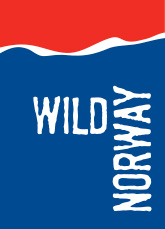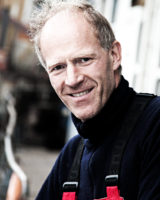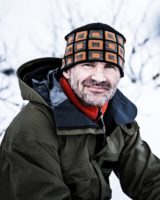Day 1:
Leave home. The usual routing (for Europeans) is to fly out in the afternoon, either via Paris, London, Madrid or Frankfurt. For the long overnight flight to Santiago we prefer to seat ourselves on the right-hand side. That will ensure you a splendid view of Aconcagua (6962m – Highest mountain in America and one of the Seven Summits) just 17 minutes before landing.
Day 2:
To land, early in the morning, in the super comfortable summer of Santiago is bliss, and if you have a late flight to Punta Arenas you may sneak in a lunch at downtown Mercado Central – that certainly will make you sleep heading further south…
Anyway, if you happen to be awake, try to sit on the left side on this leg as the impressive Andes Mountain Range will fill your view with snow-clad peaks and volcanoes for the duration of the flight. And a long flight it is, as Chile stretches forever south towards the Cape Horn. Well arrived, you meet the guide, check in to the hotel and the team goes for the first dinner together.
Day 3:
This is preparation time. We will all join together to finalize everything and be sure we are 100% ready before flying into Antarctica. This is also an important exercise and we need to get our heads into what we bring and how the operation work: equipment, food, sledges, routines, safety, emergency, navigation etc. Needless to say, work is punctuated by dinner and Punta has in fact some really great restaurants – Sleep should be no problem.
Day 4:
The day will have more programs than you may think. We will attend an Antarctic briefing with the folks that do the logistics for us. They will show us how serious the cold can be and go through rules, guidelines and advice for Antarctic travels and flying. Then we are going to bring our equipment to the airport, weigh it in and cross our fingers we will not exceed our weight allocation as overweight charges hurt. We keep a small bag of basics and warm clothing which we take as hand luggage on the plane. Extra luggage can be stored at the hotel.
Day 5:
We will from early morning be stand-by at the hotel. No one flies into Antarctica unless they know conditions are perfect. The distances, the cold, the nature, the total lack of infrastructure means the flight operator and pilots will be monitoring the weather very carefully. We will not get the call till they are 100% sure the weather window is big enough.
So how long we will wait at the hotel is hard to say. It could be an hour. It could be a day. Or two. Or more. But once the phone rings we will have 20 minutes to be dressed (full polar combat), checked out and be ready on the outside of the hotel. A van picks us up and we are off to the airport.
There we stamp out of Chile and will be ‘nowhere’ until we stamp back in. We then go to the Ilyushin IL76 cargo plane. It is not pretty. It has no Business class… and has big cargo hatch at the back. – The last weather update comes as we are all strapped in – then we are off.
We fly over Terra del Fuego, Cape Horn, the Drake Passage, along the stunning Antarctic Peninsula. Four and a half hour later we land at the blue ice runway at Union Glacier. To step out of the plane is a tremendous feeling. It is so clear, so dry, so cold and so good you will fall in love there and then.
After being transported to the camp we pitch our tents and ready everything in case we can go out at once. But most likely we will wait a day or so. In the meantime, food is served for us in the huge mess tent, but we sleep in our own tents and get a good feel for it all. Already the next day our bodies are much better acclimatised to the cold!
Day 6 -7:
The next leg on our journey is by smaller planes with skis. Again we wait for the weather. Once cleared, we pull our stuff across to the snow runway close to camp. Off we are for a long haul and the Antarctic vastness will dawn on you. After about another 4,5 hours flight we are close to our destination and the pilots starts to look for a smooth place to land. We tumble out and moments later the plane roars off.
The silence we are left with is total and we feel more alone than ever before. It is a wonderful cocktail of emotions and happiness. We strap on the harness and walk off ever so slowly.
We are at some 2800 metres. This is equivalent to some 3500 (+) metres in Himalaya. Because of the rotation of Earth, the atmosphere is thinner near the poles than near the Equator and middle latitudes. This thinner atmosphere means high latitudes also have lower atmospheric pressure and significantly less oxygen than at the same elevation at lower latitudes. We look upon this as a high altitude expedition and take our precautions. The super dry air ads up to the fact that we must drink a lot, breath more than normal and keep the pulse rate down. – So the first day we call it a day after just a few kilometres and make our first camp.
The next couple of day’s progress:
As we slowly get accustomed to the altitude, the distances will increase. On an average the typical progress rate for an expedition like this is: Day 1: 3km, Day 2: 7km, Day 3: 10km, Day 4: 12km, Day 5: 15km. Day 6: 15+km, etc. As the weather and the conditions in Antarctica are ever changing and really unpredictable, we have to expect a day or so to be weather days, so we do not know exactly how many days we have for our Last Degree. Anyway, from the 5th day on the ice, we should be able to do good distances and be able to estimate the arrival.
Day 14:
As we get nearer, specs on the horizon grow to strange buildings and huge scientific antennas appear. But our focus is just the Pole itself. It is an emotional trip down memory lane and a huge feeling. After photos and hugs we prepare camp before we are allowed a quick visit to the Station itself. It is impressive and we feel as if we might as well be somewhere in space. But then again, there is no tougher place on earth; we stand there shivering in summertime. At winter the darkness and enormous storms descend on the station that is cut off from the rest of the world for some 8 months.
This is the third South Pole station, all build by the Americans. The first one was set up as early as 1955; only 44 years after Amundsen reach the South Pole. The second one, the aluminium dome, was constructed in 1973 and dismantled in 2009. The existing station is much bigger and it really looks like a factory complex on another planet. You can read more about the South Pole Station timeline here http://www.southpolestation.com/trivia/igy1/igy1.html
Flying back:
Normally we stay for some hours at the Pole before the plane comes to pick us up. If the weather is good they do not hang about and risk us missing the big bird back to Punta. But sometimes we stay longer, the Antarctic weather always have the last word.
It is a beautiful flight back, refuelling halfway at Thiel Mountains.
Arriving back in Union Glacier is be great. We have been used to the cold and thin air at the upper Polar Plateau by now, down here it feels like summer…
We are greeted by the staff who has prepared a table and a celebration dinner especially for us.
At this time of the year, the weather is at its best and hopefully there will be no delay in getting out back to Punta Arenas. Being back is a rewarding experience, easy to enjoy; a shower, sitting on chairs, ordering food & drinks, read papers, being on-line. The adventure slowly sinks in as we again adapt to the civilisation.
Homebound:
The flight home depends on what kind of ticket you have.
A full flexible return ticket is recommended as this means you will not risk some of the disadvantages related to delays etc. Normally you can buy tickets that can be changed for a fixed sum. The trick is to book a flight a couple of weeks later than expected, and change forward when you know for sure what time you arrive in Punta.
In general our schedule is to get on the morning flight out of Punta Arenas, and arrive mid day in Santiago – and after some hours we board the plane back home.



